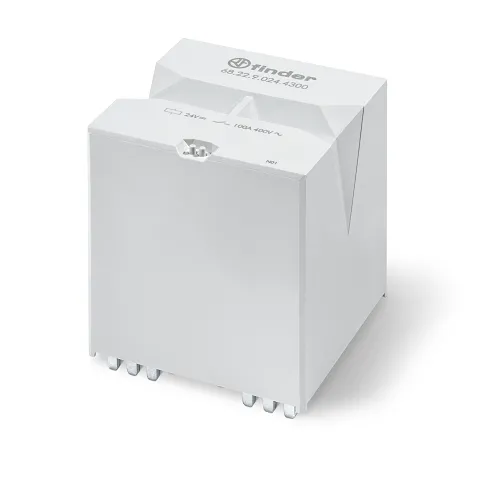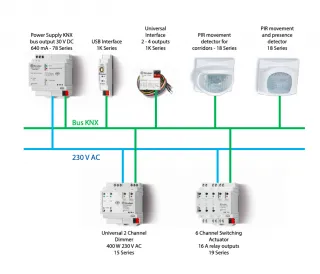What is a power relay and its use within applications?
A power relay is a reliable problem solver when it comes to switching high currents. Throughout this article, we will take a look at power relays and Finder’s product range in detail.
what is a power relay?
A power relay is a device that uses an electromagnet to open or close a circuit when the input (coil) is correctly excited. They provide a high level of isolation between the control signal (coil) and the output (contacts) – typically with a rated impulse voltage of 4 or 6kV.
A power relay may have change over (both normally open (NO) and normally closed (NC)) contacts or just normally open (NO) contacts. When NO contacts only are provided this usually means a greater contact gap when off can be provided, which is required in certain applications. Power relays are reliable problem solvers when it comes to switching high currents.
How does a power relay work?
The basic design of a power relay utilises an electromagnet (coil and iron core), an armature, a spring and one or more pairs of contacts.
With normally open (NO) contacts a small current flows through the input circuit, activating the electromagnet. The resulting magnetic field attracts the armature which moves the contacts together, completing the second circuit, allowing a large current to flow. When the source of power is removed, the armature is no longer attracted, a spring returns it to the rest position allowing the contacts to separate, stopping the flow of electricity in the second circuit and turning off the device.
In the case of a normally closed (NC) relay, it is reversed. The return spring keeps the contacts closed. When the input circuit is activated, the electromagnet attracts the armature, this overcomes the force of the return spring and the normally closed contacts separate, stopping current flow in the second circuit. As such, NC relays keep the larger circuit in the on position by default.
What is a power relay used for?
In common with all electromechanical relays, a power relay uses a small electrical current (typically tens of milliamps) to operate the contacts of an electromechanical switch that control a much larger current. For a power relay, this current is usually more than 10 Amps which makes the devices suitable for applications with higher currents.
Finder’s current power relay range extends from 12 A for the miniature 56 Series power relays up to 50 A for the 67 Series high power relays. This offers a multitude of high quality, reliable options to the end-user to ensure the performance of their applications is optimal. Finder’s power relays range includes models with larger contact gaps for specific applications (e.g., industrial and domestic appliance controls, and photovoltaic). The contact gaps available are detailed on each models’ datasheet.
Finder’s power relays range also includes PCB versions for incorporation into high current electronic system applications (e.g. Electric Vehicle Charging Equipment -EVCE). Finder’s 62 series includes models with ‘Magnetic blow’ to give enhanced DC current breaking capacity.
Finder’s new Type 68.22-4300 100 A PCB mount power relay is ideal for a variety of high-power applications such as generators, UPS, pumps, photovoltaic inverters and EV chargers.
Finder’s range of power relays

56 Series – Miniature Power Relays 12A
Finder’s 56 Series power relays include the following features (according to Type):
- AC & DC coils
- PCB or Plug-in mounting
- Flange mount option (187 Faston termination)
- Available with lockable test button, mechanical flag & LED indicator
Accessories: 99 Series
62 Series - Power Relays 16A
Finder’s 62 Series power relays include the following features (according to Type):
- AC & DC coils
- Magnetic blow-out version
- PCB mount or Plug-in mount (187 Faston) or Flange mount (250 Faston)
- NO contacts option, > 3mm contact gap
- LED, mechanical indicator & test button options

65 Series - Power Relays 20 - 30A

The 65 Series comprises power relays which include the following features (according to Type):
- AC & DC coils
- PCB mount or Flange mount (250 Faston)
- NO version, > 3 mm contact gap
66 Series - Power Relays 30 A
Finder’s 66 Series power relays include the following features (according to Type):
- AC & DC coils
- ATEX/HazLoc compliant (EX nC) option available
- PCB mount or Flange mount (250 Faston)
- 8mm, 6kV (1.2/50 μs) isolation, coil – contacts

67 Series - High power relays 50A

The 67 Series brings power relays for use in the photovoltaic sector. These devices include the following features (according to Type):
- DC coils, with only 170 mW holding power
- Contact gap ≥ 3 mm (according to VDE 0126-1-1, EN 62109-1, EN 62109-2)
- Reinforced insulation between coil and contacts
- 1.5 mm gap between PCB and relay base
- Suitable for use at ambient temperatures up to 85 °C (with energy-saving coil energization) or 70 °C (with standard coil energization)
Finder’s 68 Series 100A power relay includes the following features:
- Contact gap ≥ 3.6 mm (according to VDE 0126-1-1, EN 62109-1, EN 62109-2)
- DC coils, with 700 mW holding power
- Reinforced insulation between coil and contacts
- Suitable for use at ambient temperatures up to 85 °C
- Conforms to EN 60335-1 resistance to heat and fire (GWIT 775 °C e GWFI 850 °C)
- Cadmium free-contacts





